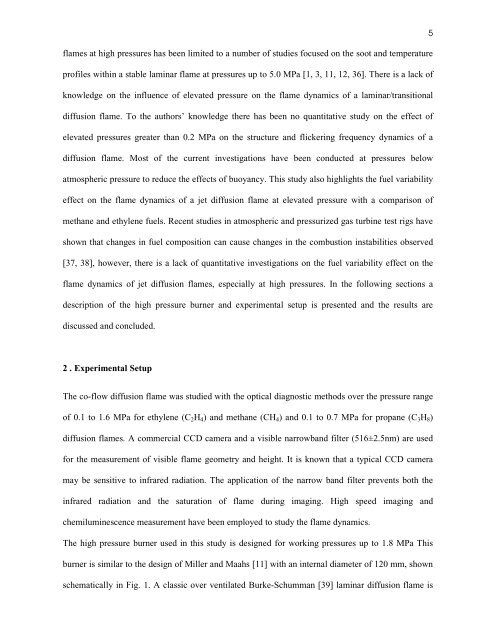FUEL VARIABILITY EFFECTS ON DIFFUSION FLAMES A
FUEL VARIABILITY EFFECTS ON DIFFUSION FLAMES A
FUEL VARIABILITY EFFECTS ON DIFFUSION FLAMES A
You also want an ePaper? Increase the reach of your titles
YUMPU automatically turns print PDFs into web optimized ePapers that Google loves.
flames at high pressures has been limited to a number of studies focused on the soot and temperature<br />
profiles within a stable laminar flame at pressures up to 5.0 MPa [1, 3, 11, 12, 36]. There is a lack of<br />
knowledge on the influence of elevated pressure on the flame dynamics of a laminar/transitional<br />
diffusion flame. To the authors’ knowledge there has been no quantitative study on the effect of<br />
elevated pressures greater than 0.2 MPa on the structure and flickering frequency dynamics of a<br />
diffusion flame. Most of the current investigations have been conducted at pressures below<br />
atmospheric pressure to reduce the effects of buoyancy. This study also highlights the fuel variability<br />
effect on the flame dynamics of a jet diffusion flame at elevated pressure with a comparison of<br />
methane and ethylene fuels. Recent studies in atmospheric and pressurized gas turbine test rigs have<br />
shown that changes in fuel composition can cause changes in the combustion instabilities observed<br />
[37, 38], however, there is a lack of quantitative investigations on the fuel variability effect on the<br />
flame dynamics of jet diffusion flames, especially at high pressures. In the following sections a<br />
description of the high pressure burner and experimental setup is presented and the results are<br />
discussed and concluded.<br />
2 . Experimental Setup<br />
The co-flow diffusion flame was studied with the optical diagnostic methods over the pressure range<br />
of 0.1 to 1.6 MPa for ethylene (C2H4) and methane (CH4) and 0.1 to 0.7 MPa for propane (C3H8)<br />
diffusion flames. A commercial CCD camera and a visible narrowband filter (516±2.5nm) are used<br />
for the measurement of visible flame geometry and height. It is known that a typical CCD camera<br />
may be sensitive to infrared radiation. The application of the narrow band filter prevents both the<br />
infrared radiation and the saturation of flame during imaging. High speed imaging and<br />
chemiluminescence measurement have been employed to study the flame dynamics.<br />
The high pressure burner used in this study is designed for working pressures up to 1.8 MPa This<br />
burner is similar to the design of Miller and Maahs [11] with an internal diameter of 120 mm, shown<br />
schematically in Fig. 1. A classic over ventilated Burke-Schumman [39] laminar diffusion flame is<br />
5
















